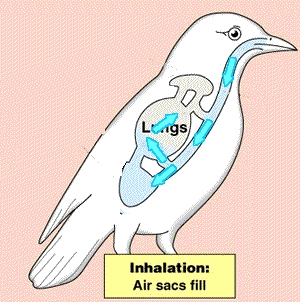
The avian respiratory system works in much the same way as the mammalian respiratory system. It delivers oxygen to the tissues and removes carbon dioxide. In addition, the respiratory system plays an important role in maintaining normal body temperature (thermoregulation).
Although the function of the avian respiratory system is similar to that of mammals the avian respiratory system is different from that of other vertebrates. Birds have relatively small lungs plus nine air sacs that play an important role in respiration. These air sacs are not involved in gas exchange but act as reservoirs of air.
The avian respiratory system allows normal activity at high altitudes, where air pressure is low, through efficient extraction of oxygen from the air. This efficient mechanism of gas extraction enables birds to maintain a higher metabolic rate than mammals.
The air sacs permit a unidirectional, constant flow of air through the lungs. Unidirectional flow means that air moving through bird lungs is largely fresh air as opposed to the tidal volume in mammals, which moves in and out of the lungs. The mammalian respiratory system is inefficient when compared to the avian respiratory system due to the fact that incoming air into a mammal's lungs is mixed with stale and deoxygenated air. The tidal nature of air movement in and out of mammalian lungs leaves a residual volume behind after exhaling.
